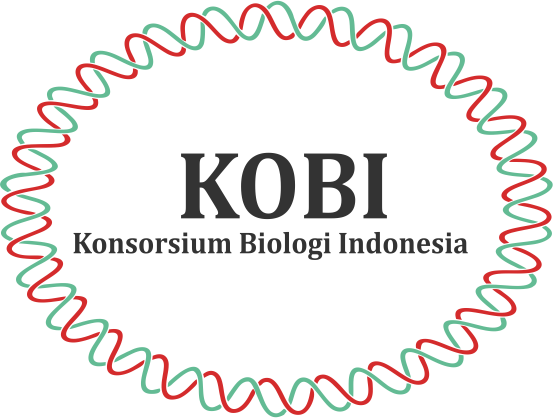Carbon Stock of Australian pine (Casuarina equisetifolia) in Cemara Sewu Beach Jetis Cilacap
Abstract
Beach is home to the richest ecosystems in the world and many components of the vegetation that store large amounts of carbon stock. Carbon compounds in the atmosphere are absorbed and metabolized. The metabolic products are stored in tree biomass. Cemara Sewu Beach is one of the beach that has a relatively large amount of stored carbon potential. The purpose of this study was to determine the carbon stored in several types of trees at Cemara Sewu Beach. The method used in this study is a survey method with purposive sampling using without destroying. The sampling of Australian pine tree stands is grouped into certain diameter class. The coastal area was made into three research stations and each study was made into 5 replicated plots measuring 20 m x 20 m and placed on a transect line with a distance of 5 meters each. All of the Australian pine were plotted as samples. The main parameters observed were tree density, trunk diameter and the number of individuals for each tree species were calculated. The results of the research on the diameter class of Australian pine greatly affect the presence of biomass and carbon stock. The results obtained that carbon stocks in diameter class 15-20 store 74,914 ton.ha-1, diameter class 21-25 as many as 164,599 ton.ha-1, diameter class 26-30 as many as 270,372 ton.ha-1, diameter class 31-35 store stocks carbon 462,478 ton.ha-1 and in the diameter class 36-40 store as much as 462,478 ton.ha-1. The larger the class diameter, the greater the carbon stock produced. The diameter class of Australian pine stands has a relationship between biomass and carbon stock, and has an exponential relationship
References
Anggreini, D., 2020. Penerapan Model Populasi Kontinu pada Perhitungan Proyeksi Penduduk di Indonesia (Studi Kasus: Provinsi Jawa Timur). E- Jurnal Matematika, 9(4), pp.229-235
Bachmid, F., Calvyn, F.A.S. & Janny, D.K., 2018. Estimasi Penyerapan Karbon Hutan Mangrove Bahowo Kelurahan Tongkaina Kecamatan Bunaken. Jurnal Pesisir dan laut Tropis, 1(1), pp.8-13.
Brown, S., 1997. Estimating Biomass and Biomass Change of Tropical Forest a Primer. Rome: FAO Forestry Paper.
Butarbutar, T., 2009. Inovasi Manajemen Kehutanan untuk Solusi Perubahan Iklim di Indonesia. Jurnal analisis kebijakan kehutanan, 6(2), pp.121-129.
Chen, L., Meng, L. & Si-Long, W., 2016. Carbon Stock Density in Planted versus Natural Pinus massoniana Forests in sub-tropical China Annals of Forest Science, 73(1), pp.461-472.
Cox, G.W., 1971. Laboratory Manual of General Ecology. Second Edition. Dubuque: Brown.
Favaretto, R.F., Marlove, F.B.M., Tales, P., Jaqueline, R.T.K., Vinicius, S.F., Jessica, E.R. & Janaina, S.S., 2018. Morphological, Physiological and Molecular Characterization of Fusarium lacertarum Causal Agent of Damping-off in Casuarina equisetifolia. Revista Brasileira de Cilencias Agrarias, 13(2), pp.1-6.
Hairiah, K. & Rahayu, S., 2007. Pengukuran Karbon Tersimpan di Berbagai Macam Penggunaan Lahan. World Agroforestry Centre, Bogor: IC RAFSA
Hamilton, N.M. & King, N., 1988. Daerah Aliran Sungai Hutan Tropika. Yogyakarta: Universitas Gadjah Mada.
Hardjana, A.K., 2019. Biomass and Carbon Potential of Forest Plantation of Acacia mangium in HTI. Jurnal Penelitian Sosial dan Ekonomi Kehutanan, pp.237 - 249.
Hikmatyar, M.F., Tubagus, M.I., Ario, P.P., Sayyidah, S. & Avan, R., 2015. Estimasi Karbon Tersimpan pada Tegakan Pohon di Hutan Pantai Pulau Kotok Besar, Bagian Barat, Kepulauan Seribu. Jurnal Biologi, 8(1), pp.40-45
Huang, R., Pan, C., Yuan, W., Huimin, Li., Linzhi, Z., Yaqian, Z. & Lei, Li., 2020. Structural Variability and Niche Differentiation of the Rhizosphere and Endosphere Fungal Microbiome of Casuarina equisetifolia at Different Ages. Brazillian Journal of Microbiology. 1(1), pp.1-12.
Kauffman, J.B. & Donato, D.C., 2012. Protocols for the Measurement, Monitoring and Reporting of Structure, Biomass and Carbon Stocks in Mangrove Forest. Working Paper 86. Bogor: Center for International Forestry Research.
Ketterings, Q.M., Coe, R., van Noordwijk. M., Ambagau,
Y. & Palm, C.A., 2001. Reducing Uncertainly in the Use of Allometric Biomass Equations for Predicting Above-ground Tree Biomass in Mixed Secondary Forests. Forest Ecology and Management, 146, pp.199-209.
Kurniawan, H. & Dhany, Y., 2015. Potensi Simpanan Karbon pada Tiga Tipe Savana di Nusa Tenggara Timur. Jurnal Penelitian Kehutanan Wallacea, 4(1), pp.51-62.
Lee, J., Lin, Y. & Ming, L., 2019. Wind Affects the Growth Root Anchorage and Tensile Strength of Australian Pine (Casuarina equisetifolia) Seedlings. Journal of Forest Research, 24(4), pp.219-229.
Lin, J., Meimei, W., Mingguo, M. & Yilin., 2018. Aboveground Tree Biomass Estimation of Sparse Subalpine Coniferous Forest with UAV Oblique Photography. Remote Sensing, 10, pp.1-19.
Lukito, M. & Rohmatiah, A., 2015. Pendugaan, Biomassa dan Karbon Tanaman Jati Hutan Rakyat dalam Mengabsorsi Karbondioksida (CO2) Desa Kare Kecamatan Kare Kabupaten Madiun. Agri-tek, 16(2), pp.1-23.
Muslim, A., 2017. Australian Pine Cones Based Activated Carbon for Adsorption of Copper in Aqueous Solution. Journal of Engineering Science & Technology, 12(2), pp.280-295.
Napitu, P., 2007. Pengelolaan Kawasan Konservasi. Yogyakarta: Universitas Gadjah Mada.
Natalia, D., Yuwono, S.B. & Qurniati, R., 2014. Potensi Penyerapan Karbon pada Sistem Agroforestri di Desa Pesawaran Indah Kecamatan Padang Cermin Kabupaten Pesawaran Provinsi Lampung. Jurnal Syfa Lestari, 2(1), pp.11-20
Priosambodo, D., Khairul, A. & Mahatma, L., 2019. Spesies Tumbuhan Asli Introduksi dan Invasif di Pulau Barrangcaddi Sulawesi Selatan. Jurnal Ilmu Kelautan, 5(1), pp.5-10.
Putri, A.H.M. & Wulandari, C., 2015. Potensi Penyerapan Karbon pada Tegakan Damar Mata Kucing (Shorea javanica) di Pekon Gunung Kemala Krui Lampung Barat. Sylva Lestari, 3(2), pp.13-20.
Rahayu, S.B., Lusiana, B., & Noordwijk, M.V. 2007. Pendugaan Cadngan Karbon di Atas Permukaan Tanah pada Berbagai Sistem Penggunaan Lahan di Kabupaten Nunukan, Kalimantan Timur. Bogor: World Agrororestry Centre, ICRAF Southeast Asia Regional Office.
Salunkhe, O., Khare, P.K., Richa, K. & Khan, M.L., 2018. A Systematic Review on the Aboveground Biomass and Carbon Stocks of Indian Forest Ecosystems. Journal Ecological Processes, 7(17), p.1-12.
Sampurno, 2001. Pengembangan Kawasan Pantai Kaitannya dengan Geomorfologi. Bandung: Pusat Penelitian dan Pengembangan Permukiman.
Sari, K.L., Endang, H. & Tanto, I., 2018. Potensi Ekowisata Pesisir Cilacap (Potential of Coastal Ecotourism in Cilacap). Prosiding Seminar Nasional and Call for Papers: Pengembangan Sumber Daya Perdesaan dan Kearifan Lokal Berkelanjutan VIII, pp.14-35.
Schwerz, F., Durval, D.N., Braulio, O.C., Liliane, B.T., Jaqueline, S., Elder, E., Elvis, F.E. & Luiz, G.C., 2020. Carbon Stock Partitioning and Wood Composition in Short-Rotation Forestry System Under Reduced Planting Spacing. Annals of Forest Science, 77(67), pp.1-18.
Sutaryo, D., 2009. Penghitungan Biomassa Sebuah Pengantar untuk Studi Karbon. Bogor: Wetlands International Indonesia Programme
Suwardi, A.B., Mukhtar, E. & Syamsuardi., 2013. Komposisi Jenis dan Cadangan Karbon di Hutan Tropis Dataran Rendah, Ulu Gadut, Sumatera Barat. Berita Biologi (12)2, pp.169-176.
Talbot, G. & Dupraz, C., 2011. Simple Models for Light Competition within Agroforestry Discontinuous Tree Stands: Are Leaf Clumpiress and Light Interception by Woody Parts Relevant Factors. Agroforest Syst, 84(1), pp. 101-116














_copy.png)



